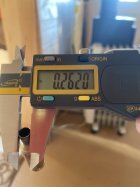For many years I used a 0.248" bushing with Lapua brass to load 90 VLDs for shooting F-TR matches with a .223 Rem bolt gun (Redding Type S die, Redding SS Bushing). It would yield a loaded neck diameter of 0.250" exactly as you described.
The only issue was that I would notice that maybe in one out of five or one out of ten loaded rounds, the seating force was noticeably different that the rest (i.e. harder or easier). I attributed this issue to likely variance in neck wall thickness. The solution I adopted was to use a bushing that was .001" smaller (i.e. 0.247") to size the necks first to a diameter slightly smaller than I had been doing when the bushing die was the sole sizing step, then opening the necks up in a second neck-sizing step using a 0.2225" mandrel (21st Century). A mandrel that is .0015" under bullet diameter should yield very close to .002" neck tension/interference fit (due to brass springback), as long as the selected bushing sizes all the necks just a tick smaller so the mandrel has to do some work to open all the necks back up just a tiny bit.
To cover all your bases with .223 Rem (i.e. due to different brands of brass, variance in bushing diameters from the manufacturer, using/not using a mandrel, etc.), I would suggest getting 0.245", 0.246", 0.247" and 0.248" bushings. In my hands, these four bushings will cover just about everything. I use the Redding SS bushings with their Type S die sets. You can also go with titanium nitride, but they're more expensive, so I might wait and see which SS bushing gets used the most before going that route.











